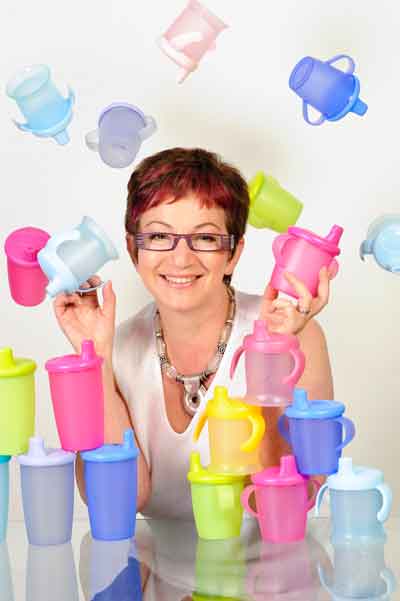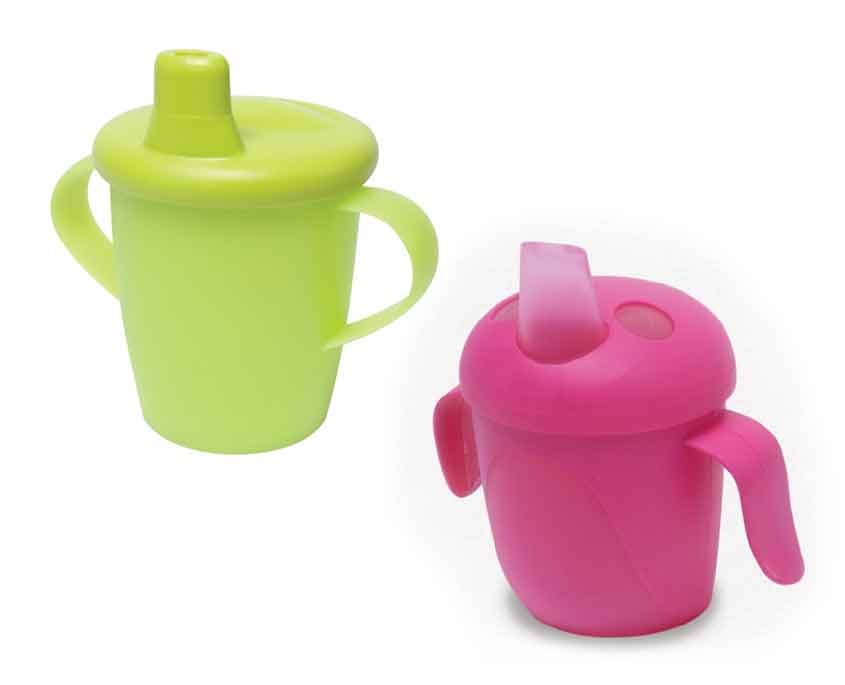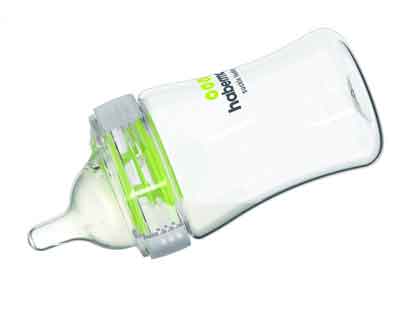
Nursery feeding made simple
By Mandy Haberman, founder, Haberman Baby
British inventor and entrepreneur Mandy Haberman is a 21st-century mother of invention. The Haberman® Feeder, the Anywayup® non-spill toddler trainer cup and the Suckle Feeder have revolutionized the nursery industry and brought relief to millions of families around the world. She shares her story and explains how intellectual property (IP) is the backbone of her company.

and the Suckle Feeder developed by British inventor and entrepreneur
Mandy Haberman have revolutionized the nursery industry and
brought relief to millions of families around the
world (photo: Courtesy of Haberman Baby)
How it all began
I didn’t grow up dreaming of becoming an inventor. I was creative and studied at Hornsey College of Art in the United Kingdom, followed by a degree in graphic design from Saint Martin’s School of Art in London. But the drive to create products that solve problems was in my blood. The metamorphosis from graphic designer to inventor took place after our third child, Emily, arrived in 1980. She was born with Stickler’s Syndrome and among other problems, had severe difficulty feeding. After four months with a nasogastric tube, it was essential that she start feeding orally to be discharged from hospital. No available bottles worked, so I had to improvise. In my case, necessity really was the mother of invention. When Emily was two years old, I started developing my improvised prototype into a marketable product which became known as the Haberman Feeder. Initially sold by mail-order from my kitchen table, it has now been used for over 35 years in hospitals around the world to help babies with feeding difficulties and improve their families’ quality of life.
All my subsequent inventions have begun with the identification of a problem that needs solving. For example, with three small children I was well aware of the inadequacy of trainer cups. Drinks spilled, making puddles and stains everywhere. I spent half my life mopping floors! Watching someone else’s toddler run across a friend’s cream carpet, leaving a trail of blackcurrant juice in her wake was the inspiration for another invention, the Anywayup® Cup, which seals automatically as soon as it leaves a child’s mouth.
My latest invention is the Haberman Suckle Feeder. This, too, was a response to an identified problem: medical research has proven that babies fed by bottle with breast milk or formula are at significantly increased risk of developing obesity in later life.
Self-regulation of appetite is established very early on in life. Bottle feeding typically causes over-feeding and compromises self-regulation, setting a lifetime pattern for over-eating. By 26 weeks of age, 99 percent of babies in the United Kingdom will be using a bottle at least some of the time, so it was important to find a solution. That is why we came up with the Haberman Suckle Feeder. It is designed to emulate breastfeeding, enable naturally paced feeding and reduce the long-term health risk factors for obesity, heart disease and diabetes associated with other bottle-feeders.
The buzz of invention
Reaching a simple and elegant solution that will make a difference to people’s lives gives me a real buzz. I will spend months, sometimes years, working on a project then, when I get that “lightbulb moment,” I know I’ve got it right.
Being an inventor and an entrepreneur suits my way of working. I’m obsessive and will often be awake in the early hours of the morning, writing notes in the dark. I’ve even been known to jot down ideas while waiting for traffic lights to change. Being an inventor is more of a lifestyle than a career. I literally go with the flow.

The role IP plays in our business strategy
All my inventions have been patented. When I patented my first invention it was a steep learning curve. For the Haberman Feeder I secured patent and trademark rights in the United Kingdom only, but was still able to negotiate a five-year global licensing deal with a Swiss company based on know-how. The product had a strong reputation in the medical world, particularly in the United States. As the expiry date for that initial license neared, I applied for a trademark in the United States for the name “Haberman” and then negotiated a trademark license with their US sister company.
I was more IP aware when it came to protecting my second invention, the Anywayup® cup, a leak-proof children’s trainer cup with valves to control the flow of liquid. I acquired a raft of IP rights including trademarks, 3D trademarks and patents. In hindsight, I wish I had also registered design rights, as several of my cups became iconic designs. For this invention, I knew I needed secure patent rights in multiple countries, not just the United Kingdom, so I opted to use the Patent Cooperation Treaty (PCT) to apply for patents in my target markets. This worked well and, in addition to selling products under my own brand, I also exploited the IP through licensing. Approximately 50 million cups are sold each year under license.
My most recent product, the Haberman Suckle Feeder, is also patented in all significant markets. We plan to follow a similar strategy and exploit the IP through licensing in addition to direct sales. Currently, we have licenses in Eastern European countries. Asia and the United States are next on the agenda.
The best advice that I can give to young women with aspirations to invent, create and set up a business is believe in yourself.
Mandy Haberman, founder, Haberman Baby
IP has been the backbone of my business for over 35 years. We develop IP, bring the resulting products to market then further exploit those rights through licensing. This allows us to generate significant value from the sales of companies that would otherwise be competitors. And that is one of the great benefits of IP.
Challenges
Building a business based on creating and exploiting IP is challenging, particularly for a start-up with finite resources. Even with patents in place, established, well-resourced competitors have copied my ideas and grabbed market share, devastating the sales potential of my businesses.
The Anywayup® cup was a rapid commercial success. It was a small invention but it answered a very real and long-felt need. About 18 months after its launch, Jackel International (brand name Tommee Tippee), the then UK market leader in children’s cups, infringed my patent. Going to the High Court to enforce my rights was an exceedingly difficult decision. When the infringement took place, I was not operating as a limited liability company, so if we lost the case I risked losing my house. Fortunately, we won at first instance and an acceptable settlement was reached shortly before the scheduled appeal. Establishing the validity of my UK patent in court gave me the confidence to deal with infringements elsewhere, and enforcing my rights in the United States led to some very valuable licensing deals.
I now have a reputation in the industry so competitors think twice before infringing my patent rights.
Why design matters
We launched the Anywayup® cup in rather a rush. I exhibited my working model prototypes at two nursery-industry exhibitions simply to test the market. To my surprise, we received advance orders worth GBP 10,000, so we had to get into production very rapidly. There was no time or budget to consider aesthetics. Despite that, it was a success. We sold half a million cups in the first year, and the business was in profit.

naturally-paced feeding (photo: Courtesy of Haberman Baby).
While the Anywayup® cup contained breakthrough technology that parents desperately wanted, it looked no different from the ordinary trainer cups available at that time. I felt sure that if it stood out visually from the crowd, sales would grow much faster.
That led me to work with Sebastian Conran to re-design the Anywayup® range. He gave it the necessary “wow” factor and our sales really took off, achieving 40 percent of the UK market. We grabbed market share before our competitors had time to draw breath.
You can have the greatest technology in the world but unless it catches the eye of consumers, they won’t pick it up off the shelf.
Keys to success
My success has been down to six things:
- identifying the right problem to solve;
- having enough awareness of IP to ensure that my ideas were adequately protected in key markets;
- total commitment to bringing the product from concept to market;
- building the right team;
- the courage to enforce my rights; and
- belief in my product and myself.
Why is it important to encourage girls and women in innovation and creativity?
Women account for over half the population, and while they are increasingly part of invention teams – female inventorship has risen by 16 percent in the UK in the last 10 years – they rarely patent independently. According to a recent study by the Institute for Women’s Policy Research, women held fewer than one in five patents in 2010, and only 8 percent of women are primary inventors.
This patent gender gap seems odd to me because women are naturally innovative. We find practical solutions to problems on a daily basis in family life. The problem is that too few women pursue studies or careers in patent-intensive subject areas. Clearly, more needs to be done to motivate and attract women into engineering, science, computer science, technology and innovation so that they can direct their talents to solving important social and scientific problems.
Certainly, in the UK there are fantastic resources, such as the British Library’s IP and Business Centre, to support innovation and entrepreneurship. Women have no shortage of creative and entrepreneurial ideas. So what is holding them back?
Invention, innovation and entrepreneurship are most often speculative. It can take years of research, development and preparation before a revenue stream is achieved. Where patents are involved, costs ramp up rapidly, often before any income can be derived. This can be managed more easily in established organizations where women will generally work within a team. However, women with young families are frequently micro start-ups, working from home. They pursue their ideas on a shoestring budget and are often self-funded. Financing all of this and childcare costs, in order to free up time to focus on work, is often prohibitive. There are plenty of business support services available but the practicalities and financial scope for women to take advantage of them is often limited.
I would like to see more women being given the support and time they need to develop their IP and bring ideas to market. Perhaps policymakers could develop a way to subsidize childcare support for female inventors and start-up entrepreneurs, beyond that currently provided by the State.
The landscape will gradually change, as generations of girls complete their education with a firm expectation of gender equality. If female role models are given prominence and girls are sufficiently encouraged, more women will no doubt pursue careers in sciences, computer science, technology and entrepreneurship. However, to encourage more young people (male and female) to invent, patent and generally achieve the full value of their creative potential, IP education needs to be seen as an essential part of the curriculum in all subjects where IP features in its various forms – engineering, art/design, computer science, literature, medicine, health sciences, music and more – at all universities, business schools and higher education establishments. It grieves me that year after year, our wonderful design schools publicly display work of significant potential value without safeguarding students’ IP.
Advice to aspiring inventors
The best advice that I can give to young women with aspirations to invent, create and set up a business is believe in yourself. There will be challenges, pitfalls as well as soaring highs but in the world of invention and entrepreneurship, there are no glass ceilings. The only limits to your ambition are those you impose on yourself. Any problems or difficulties that you might encounter along the way are not gender biased – it’s tough for everyone! If you have an inspired idea that you believe in, get out there and do it. You’ll never look back.
The WIPO Magazine is intended to help broaden public understanding of intellectual property and of WIPO’s work, and is not an official document of WIPO. The designations employed and the presentation of material throughout this publication do not imply the expression of any opinion whatsoever on the part of WIPO concerning the legal status of any country, territory or area or of its authorities, or concerning the delimitation of its frontiers or boundaries. This publication is not intended to reflect the views of the Member States or the WIPO Secretariat. The mention of specific companies or products of manufacturers does not imply that they are endorsed or recommended by WIPO in preference to others of a similar nature that are not mentioned.